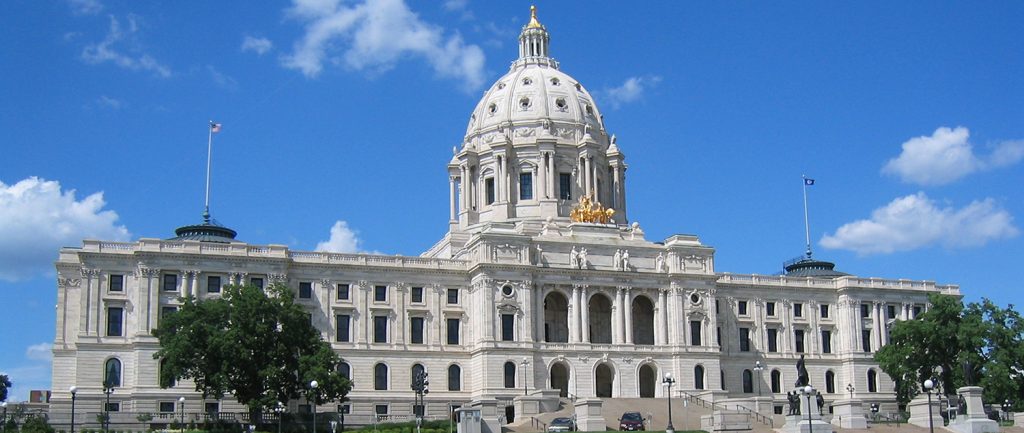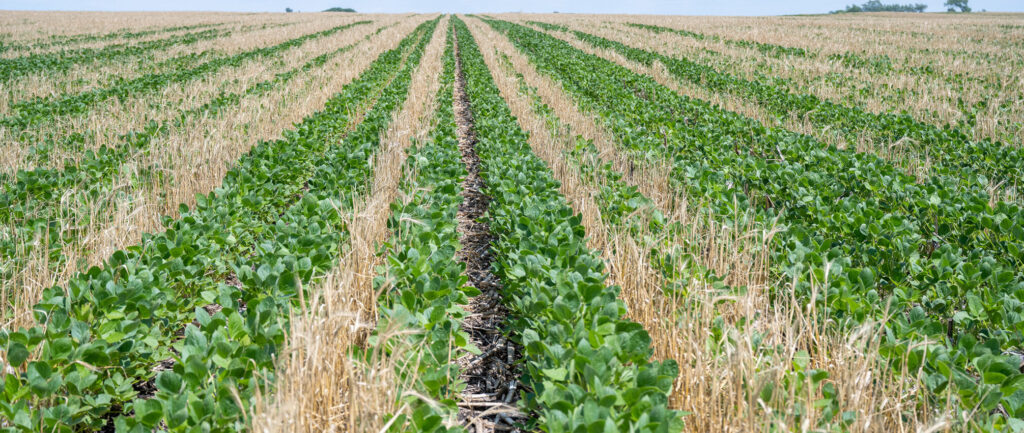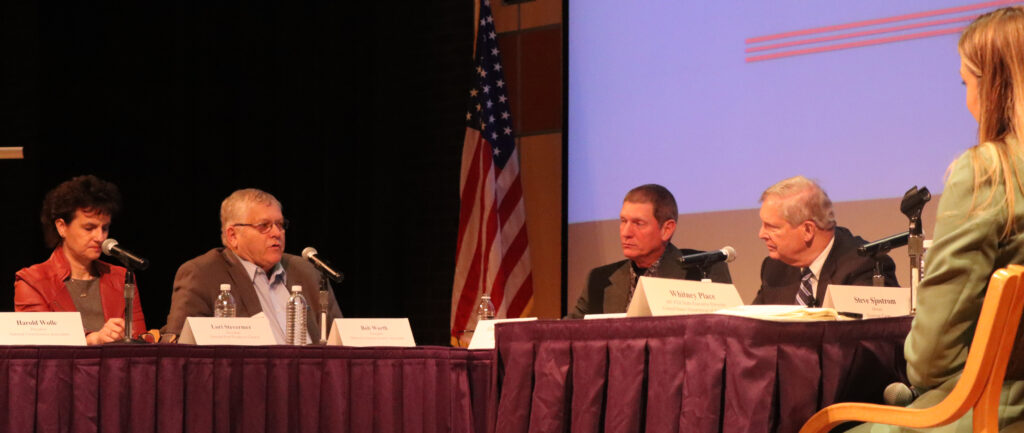According to findings released this week from the Minnesota Board of Water and Soil Resources (BWSR), 74 percent of Minnesota’s counties are already 60–100 percent compliant with the state’s bipartisan water quality buffer initiative. BWSR’s preliminary analysis comes as the Minnesota Department of Natural Resources (DNR) announced the state’s water quality buffer protection map is now complete.
After collecting almost 4,200 public comments from landowners and local governments, the DNR has made nearly 2,800 changes to Minnesota’s water quality buffer map to remain flexible to the needs of local landowners. The bipartisan law’s flexibility, combined with additional financial resources proposed in Governor Mark Dayton’s budget, will help all landowners participate fully in the statewide effort to improve water quality and wildlife habitat across Minnesota.
“I want to thank the great many farmers, other landowners, and local officials across Minnesota for their leading efforts to protect and improve the quality of our water,” said Governor Dayton. “We will continue to work with farmers and other landowners in every county to find flexible solutions that, together, will improve the quality of our water for ourselves and for future generations.”
Governor Dayton signed bipartisan legislation in 2015 to establish Minnesota’s water quality buffer initiative. The effort is designed to reduce phosphorous, nitrogen, and sediment from entering Minnesota’s lakes and streams to improve water quality statewide. After receiving additional feedback from farmers and landowners across Minnesota, Governor Dayton in 2016 signed another bipartisan bill into law making changes to the program to provide more flexibility and clarity for Minnesotans. With more than 40 percent of the state’s waters polluted or impaired, the need for this initiative is clear. Fifty-foot buffers are effective in removing approximately 70 percent of nitrogen in runoff.
“Minnesota farmers should be commended for their initial efforts to help improve the state’s water resources,” said Agriculture Commissioner Dave Frederickson. “Our farmers have committed to being national leaders in land and water stewardship by installing buffers and enrolling in the Minnesota Ag Water Quality Certification program, which can serve as an alternative to the buffer requirement. With the ag community’s continued hard work, we know we can make an impact to improve our environment.”
In his 2017 budget proposal, Governor Dayton has proposed a slate of additional financial assistance to help farmers and landowners across Minnesota fully participate in the water quality buffer initiative. These financial resources would supplement existing financial resources already available to Minnesota farmers and landowners for water quality conservation efforts on their land. Additional information about the Governor’s budget proposals is included below.
Nearly 2,800 Changes Made to Buffer Map Based on Landowner, Local Government Feedback
After processing almost 4,200 public comments submitted by landowners and local governments, the Minnesota Department of Natural Resources (DNR) announced today that Minnesota’s water quality buffer map is complete. In response to those comments, the DNR has made nearly 2,800 changes to Minnesota’s water quality buffer protection map. These changes ensured the initiative’s integrity, reflecting the feedback of landowners and local officials in a cooperative effort to improve the quality of our lakes, streams, and drinking water. This progress, paired with the high compliance rates already reported by many local governments, demonstrate that Minnesota is ready for the upcoming deadlines for compliance.
“Our message to local landowners, and local governments is: we have heard you, and we thank you for your partnership in this process. The DNR’s role is to build and maintain the buffer protection map, and the mapping process has gone extremely well,” said DNR Commissioner Tom Landwehr. “Working with landowners and local governments, the DNR was able to develop an even better buffer map, and make changes in an efficient and transparent way.”
Becky Alexander is with the Cottonwood Soil and Water Conservation Service (SWCD) and is a former Cottonwood County Commissioner. According to Alexander, the Minnesota DNR has provided tools and services that have helped SWCDs across Minnesota make rapid progress with farmers and landowners. Those tools have helped ensure that SWCDs, and the landowners they work with every day, have had a seat at the table throughout the public engagement process.
“The DNR’s mapping process was open and engaging. Their buffer mapping tool made it easy to enter comments from staff and landowners last spring,” said Alexander. “We were then able to track public comments and decision making about a particular watercourse segment and how it would be updated on the buffer map. The three DNR area hydrologists in our region have been extremely helpful as well, even going as far as coming on some sites with us.”
Soil and water conservation district staff across the state have been talking with landowners, walking the fields with them, even hosting burger and buffer nights at local bars, and these cooperative efforts are producing encouraging results.
Eight Months Before Law Takes Effect, Minnesota Making Significant Progress
According to new data released today by the Minnesota Board of Water and Soil Resources (BWSR), 74 percent of Minnesota counties are already 60–100 percent compliant with the state’s bipartisan water quality buffer initiative. BWSR’s preliminary analysis is based on reports collected from local Soil and Water Conservation Districts (SWCDs) and local governments across Minnesota. A full map showing preliminary compliance rates, eight months ahead of the first deadlines established by the bipartisan water quality buffer law, is available here.
“SWCDs around the state have been working closely with landowners to help them understand the law and get practices on the ground and the results of that work are very encouraging,” said BWSR Executive Director John Jaschke. “Our local government partners have the relationships with landowners and the knowledge of the landscape to get the job done.”
The new BWSR data shows compliance in west-central Minnesota’s Pope County has already reached 94 percent. In Watonwan County, in the south-central part of the state, the SWCD estimates 64 percent compliance. Where questions about the location of buffers have occurred, the district worked closely with landowners, the DNR and the BWSR to get clarification.
In southeastern Minnesota, Goodhue County’s SWCD estimates 77 percent of the required buffers are already in place. Some landowners there have worked closely with the SWCD on alternatives to buffers including managed grazing, installation of hayable buffers, native prairie plantings, and enrollment in federal programs like the Conservation Reserve Program. Farmers on the 3,200 acres in Goodhue County that have received Agricultural Water Quality Certification automatically qualify as meeting the new law.
| Initial Compliance with Minnesota’s Water Quality Buffer Initiative (March 2017) | |||||
| County | Percent Complete | County | Percent Complete | County | Percent Complete |
| Aitkin | 99 | Anoka | 99 | Becker | 97 |
| Beltrami | 96 | Benton | 87 | Big Stone | 41 |
| Blue Earth | 82 | Brown | 64 | Carlton | 95 |
| Carver | 93 | Cass | 100 | Chippewa | 55 |
| Chisago | 97 | Clay | 76 | Clearwater | 98 |
| Cook | 100 | Cottonwood | 60 | Crow Wing | 99 |
| Dakota | 96 | Dodge | 96 | Douglas | 90 |
| Faribault | 58 | Fillmore | 85 | Freeborn | 77 |
| Goodhue | 78 | Grant | 59 | Hennepin | 78 |
| Houston | 77 | Hubbard | 98 | Isanti | 98 |
| Itasca | 99 | Jackson | 55 | Kanabec | 73 |
| Kandiyohi | 80 | Kittson | 54 | Koochiching | 95 |
| Lac qui Parle | 55 | Lake | 99 | Lake of the Woods | 61 |
| Le Sueur | 77 | Lincoln | 76 | Lyon | 76 |
| Mahnomen | 90 | Marshall | 38 | Martin | 82 |
| McLeod | 77 | Meeker | 89 | Mille Lacs | 94 |
| Morrison | 93 | Mower | 84 | Murray | 71 |
| Nicollet | 53 | Nobles | 37 | Norman | 39 |
| Olmsted | 72 | Otter Tail | 94 | Pennington | 39 |
| Pine | 96 | Pipestone | 63 | Polk | 73 |
| Pope | 94 | Ramsey | 100 | Red Lake | 71 |
| Redwood | 53 | Renville | 42 | Rice | 83 |
| Rock | 44 | Roseau | 82 | Scott | 80 |
| Sherburne | 99 | Sibley | 63 | Saint Louis | 99 |
| Stearns | 88 | Steele | 92 | Stevens | 66 |
| Swift | Underway | Todd | 95 | Traverse | 60 |
| Wabasha | 76 | Wadena | 96 | Waseca | 75 |
| Washington | 97 | Watonwan | 50 | Wilkin | 57 |
| Winona | 80 | Wright | 96 | Yellow Medicine | 71 |
Local Choices for Alternative Practices
Minnesota’s water quality buffer initiative allows for local decision-making by Soil and Water Conservation Districts (SWCDs) to determine alternative water quality practices which meet this requirement. These alternative water quality practices can include those in the Natural Resources Conservation Service Field Office Technical Guide, or other practices determined by SWCDs, with support from BWSR.
Dave Legvold was the first farmer in Dakota County to be certified under the Minnesota Agricultural Water Quality Certification Program, which is a recognized, common alternative water quality practice. The certification program works with farmers to identify and treat every risk to water quality across their entire farm, improving water quality for all Minnesotans and earning farmers regulatory certainty. More than 350 farmers and more than 200,000 acres of Minnesota farmland have been certified under the program.
“I’m pleased the state is offering the Certification Program as an alternate to the buffer requirement because every farm is different,” said Legvold. “I’m also pleased to see these early positive results.”
To support local decision-making and assure consistency, BWSR has developed examples of some common alternative practices, including:
- Minnesota Agricultural Water Quality Certification Program – The certification program works with farmers to identify and treat every risk to water quality across their entire farm, improving water quality for all Minnesotans and earning farmers regulatory certainty. Across the state, this program has resulted in:
- 356 certified farms
- 206,533 acres certified
- 619 new best management practices generated
- 11.8 million pounds of sediment kept out of Minnesota’s lakes, rivers, and streams annually
- 17.1 million pounds of soil kept on fields annually
- 7,240 pounds of phosphorous kept out of Minnesota’s waters annually
- Alternative Strategies – These strategies use alternative forms of vegetative growth along waters otherwise requiring buffers. These alternative strategies include:
- USDA Practice Standard Filter Strip (393)
- Dry – Grassed Waterway
- Berm with negative slope
- Buffer plus conservation tillage
- Local Choices – Local SWCDs and farmers can work together to determine Field Office Technical Guide practices or combinations of practices that help landowners find alternatives that best fit their land. An understanding of a landowner’s operations and landscapes, and providing options, is key to the successful use of alternative practices.
For more information on, and illustrations of, some common alternative practices, click here.
About the Water Quality Buffer Initiative and Upcoming Deadlines
Minnesota’s water quality buffer initiative was enacted in 2015 with bipartisan support, and updated in 2016 to provide additional flexibility and certainty for Minnesota landowners and local governments. The initiative establishes new perennial vegetation buffers along rivers, streams, lakes, public ditches and some wetlands. Buffers protect Minnesota’s water resources by helping filter out phosphorus, nitrogen and sediment, and stabilizing banks. The DNR built the map for where buffers are required using the state’s public waters inventory and public ditch records provided by county and watershed district drainage authorities, and created online comment tools to help resolve landowners’ change requests and questions.
Compliance deadlines under the buffer law are as follows:
- Nov 1, 2017 – 50-foot average width (30-foot minimum width) buffers, or alternative practices, must be in place on lands adjacent to public waters and identified and mapped on the buffer map.
- 1, 2018 – 16.5-foot minimum width buffers, or alternative practices, must be in place on lands adjacent to public ditches as identified and mapped on the buffer map.
The DNR has details about Minnesota’s buffer protection map and answers to Frequently Asked Questions at mndnr.gov/buffers. Information about implementation of the law can be found on BWSR’s website: bwsr.state.mn.us/buffers.
More Financial Assistance for Landowners Included in Governor’s Budget
Numerous financial assistance programs already exist to help Minnesota farmers and landowners implement clean water conservation practices on their land. In addition to those existing financial resources, Governor Dayton this session has proposed significantly more funding to help Minnesota landowners participate fully in the state’s water quality buffer initiative. Those proposals include:
- Partnering with Farmers to Improve Water Quality – Governor Dayton recently signed a landmark agreement with the U.S. Department of Agriculture (USDA) to invest $500 million ($350 million federal, and $150 million state) in a partnership with farmers to improve water quality in Minnesota. The initiative provides direct payments to farmers who voluntarily improve their conservation practices for better water quality. Governor Dayton’s Jobs Bill includes $30 million for the first installment of the state’s share of this essential funding.
- Support for Buffer Implementation – The Governor’s Tax Bill includes $6.7 million in financial assistance for farmers for installing water quality buffers, alleviating the cost of buffer installation by providing eligible landowners $40 per acre each year for each tillable acre converted to a water quality buffer strip. It also includes $10 million in ongoing aid to support local government administration and enforcement of buffer requirements. This will ensures trusted experts in the community work with landowners to achieve compliance with this important law.
To learn more about Governor Dayton’s proposed investments for farming families and rural communities this session, click here.






